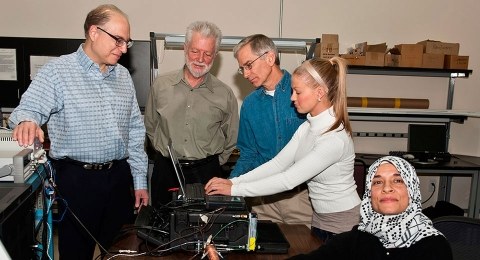
ChIMES uses chemical recognition materials called molecular recognition phases to detect chemical and biological warfare agents, toxic industrial chemicals, waterborne and airborne pollutants, explosives, and illegal drugs, just to list a few. The tiny white cylinders are the MRPs. The magneto elastic wire that runs through the MRPs wirelessly sends data to interpreting software. (Photo by Y-12 National Security Complex)
A three-year collaboration of scientists from Y‑12 National Security Complex and the University of Tennessee in Knoxville resulted in the innovation of a patented chemical sensor that is unique in several aspects: it’s inexpensive, tiny, and portable; it promises virtually limitless applications; and it allows readings through barriers.
The sensor, named ChIMES (Chemical Identification by Magneto-Elastic Sensing), received one patent last fall, and scientists anticipate approval this spring of a second patent for applications outside national security.
ChIMES is based on chemical recognition materials called molecular recognition phases, or MRPs. Using strategically selected MRPs, sensors can be made that detect chemical and biological warfare agents, toxic industrial chemicals, waterborne and airborne pollutants, explosives, illegal drugs, food pathogens, and exhaled gases that indicate disease or illegal drug use, just to name a few possibilities. In fact, the list of applications for the sensor is virtually unlimited, said Y‑12’s Vincent Lamberti, who managed the project.
“We have not been able to find any references to this technology in the literature, so it may be completely original to Y‑12,” Lamberti said. “The main advantage is the very broad range of applications made possible by the MRPs approach. If the MRPs are modular, perhaps configured as snap-in cartridges, users will be able to quickly load the appropriate sensors and respond to multiple threats with a single instrument.”
Each sensor is small—less than the width of a dime—and about the same diameter as the business ends of a cotton swab. Sensors consist of an MRPs and a ferromagnetic wire. There are no moving parts, and the sensor communicates wirelessly with the detection system.
In simple terms, an MRPs is a material that reacts in a predictable way when it encounters a target chemical. In this Y‑12 technology, the MRPs expands as it absorbs the chemical, which imposes stress on the magneto-elastic wire inside the sensor. The stress changes the magnetic properties of the wire, and those changes can be interpreted using specialized instrumentation and software. The sensors can be arranged in an array to screen for a variety of compounds.
“If we can develop an MRPs for any target, then we have a sensor for it,” Lamberti said. “At this point, we are limited only by our imaginations,” he said.
Lamberti described the collaboration team as a three-legged stool, with his area of expertise in data analysis and the application of machine-learning to the sensor. Team member David Mee of Y‑12 brought top-level skills in instrumentation and electronics. UT chemistry professor Michael Sepaniak brought an international reputation in molecular recognition materials. Sepaniak also contributed the brainpower of two top members of his UT research group: post-doctoral researcher Nahla Abu Hatab and graduate student Nichole Crane.
“If you take one leg of that stool away, the whole thing falls apart,” Lamberti said, “We have a very fruitful collaboration with UT.”
Sepaniak said the team’s investigators each brought unique expertise to the project, which produced a synergy that led to innovation.
Hatab said she felt fortunate to collaborate with the team.
“Not only has this job given me invaluable work experience at Y‑12, it has also taught me the value of team-oriented problem solving,” she said.
Work continues to miniaturize the electronic equipment that interprets sensor data while the team seeks outside partners to invest in further development to produce ChIMES units for the mainstream market.
The most compelling attribute of ChIMES is that the sensor does not require direct contact with the readout electronics, Mee said. Most sensors require a hardwired connection to the electronics, which means inserting a lead or probe through a hole in the suspect material, container, or structure, which exposes the analyst to a risk of contamination.
“One of the things that sets this sensor apart is that it can read through barriers. That opens up so many applications where you want to see what’s going on inside a welded wall,” Mee said.
Consolidated Nuclear Security Development Director Randolph Dziendziel said the health of the nuclear security enterprise is dependent on these types of partnerships.
“CNSÂ considers university collaborations essential to the vitality of our future-focused technology. Collaboration with critical partners like UTK helps us to multiply the efforts of our internal staff with a goal of accelerating technology insertion and making a difference in how efficiently we accomplish our mission,” Dziendziel said.
The ChIMES project received funding through Y‑12’s Plant Directed Research, Development, and Demonstration Program as well as a similar program at UT, the Joint Directed Research and Development Program.





Leave a Reply